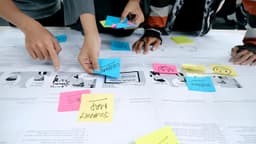A Guide to Data Analysis Methods in Machine Learning
Machine learning is transforming industries by converting vast amounts of data into actionable insights. At the core of machine learning are its data analysis methods, which enable computers to learn from data and improve accuracy over time. This article explores the three main paradigms used by machine learning algorithms: supervised learning, unsupervised learning, and reinforcement learning.
Supervised Learning: Learning with Labeled Data
What is supervised learning? It is a widely used method in machine learning with applications in spam filtering, image recognition, and predictive analytics. The term "supervised" indicates that the learning process is guided by labeled examples.
The Learning Process
In supervised learning, algorithms use labeled datasets. These datasets contain inputs paired with correct outputs. The algorithm learns to create a general rule that maps inputs to outputs. Once trained, the model can predict outcomes for new, unseen inputs.
An Example: Spam Detection
Gmail filters spam using supervised learning. Its algorithms are trained on a dataset of emails marked as spam or not. The algorithm analyzes features like subject lines and sender addresses to distinguish between spam and non-spam emails.
Techniques in Supervised Learning
Popular techniques in supervised learning include:
- Linear Regression: This models a linear relationship between input X and output Y, represented by the equation Y = aX + b, where a and b are learned parameters.
- Decision Trees: A graphical representation that uses branches to show every possible outcome of a decision based on specific conditions.
- Support Vector Machines (SVM): A classification technique that finds the hyperplane that best separates classes in the feature space.
- Neural Networks: Composed of layers of interconnected nodes or "neurons," these can learn complex patterns in data.
Unsupervised Learning: Discovering Hidden Patterns
What characterizes unsupervised learning? It is used when data lacks labels. The aim is to infer the natural structure present in a set of data points rather than to predict outcomes.
Clustering and Association
Unsupervised learning addresses two main problems: clustering and association.
- Clustering groups data points so that those in each cluster are more similar to each other than to those in other clusters.
- Association rule learning finds sets of items that frequently occur together in a dataset.
Techniques in Unsupervised Learning
Techniques in unsupervised learning include:
- K-Means Clustering: A method that divides samples into clusters, each described by the mean of the samples belonging to that cluster.
- Principal Component Analysis (PCA): A technique for reducing dimensionality in datasets, which enhances interpretability while minimizing information loss.
- Autoencoders: A type of neural network designed to learn efficient representations of unlabeled data.
Reinforcement Learning: Learning Through Interaction
What is reinforcement learning? It is a machine learning type where an agent makes decisions by performing actions in an environment to achieve cumulative rewards.
The Interaction Loop
The cycle for the agent is:
- The agent observes the environment.
- The agent selects and performs an action.
- The environment provides feedback through rewards or penalties.
- The agent adjusts its actions to maximize rewards.
An Example: Game Playing AI
Reinforcement learning has been exemplified by AI that mastered games like Go. The AI learns successful strategies through numerous games, refining its decisions based on rewards (wins) and penalties (losses).
Techniques in Reinforcement Learning
Key models used in reinforcement learning include:
- Q-Learning: A value-based model that does not require a model of the environment and can manage problems with stochastic transitions and rewards.
- Policy Gradient Methods: These learn the policy function directly, specifying actions for each state.
Reinforcement learning is particularly powerful in fields such as robotics, navigation, and real-time decision-making.
The Power of Machine Learning Methods
Each machine learning analysis method—supervised, unsupervised, and reinforcement learning—has its strengths for different tasks. By using these paradigms, businesses and researchers can extract insights from data, automate tasks, and develop systems that learn from experience.
Supervised learning is effective for predictive tasks when outcomes are known. Unsupervised learning excels at identifying patterns when data is ambiguous. Reinforcement learning enables machines to learn optimal behaviors in environments that require sequential decision-making.
These techniques continue to shape a future where machine learning plays an integral role in our daily lives and work.












